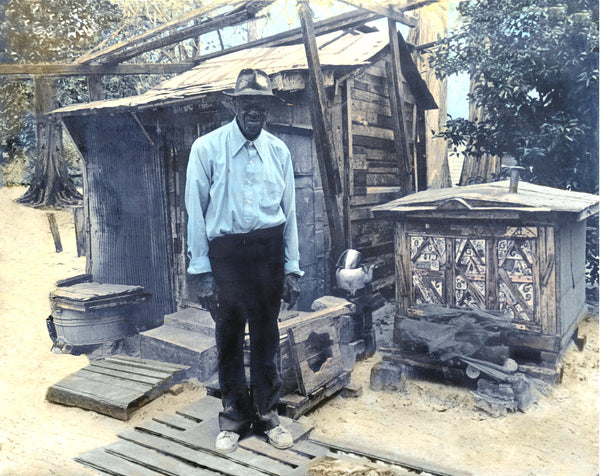First published: Summer 2013
In the unusual world of reclusive artist Ferdinand Cooper, answers most often lead to more questions. The World War II veteran built a small shack in a neighbourhood in central Florida that became his refuge from the world. He lived there by himself for nearly 50 years, with no electricity and no running water. The home was his sanctuary and he spent his life decorating it inside and out with carvings in wood and cut metal that provide a glimpse into the strange and wonderful world in which he existed.

Jimmy Allen, a self-proclaimed “Southern Picker”, has spent the past 40 years travelling the southeastern United States finding hand-crafted furniture, artworks and unusual antiques that he buys and resells.
While researching another artist in the area, Allen discovered Cooper’s house in 2000, sitting on a bare patch of dirt behind a home that once belonged to Cooper’s parents. The artist was by then nearly 89 years old and living in a nursing home nearby. Since his only living relative, a sister-in-law in Jacksonville, had no interest in the house or its contents, Cooper willingly sold the work to Allen who brought it back to his home in Atlanta. He showed his discovery to Lynne Spriggs, then the curator of Folk Art at the High Museum of Art, who purchased a small chest.
The house and all its remaining contents went to Atlanta collectors Sue and John Wieland.

Little is known about Cooper. Records show he was born in Sanford, Florida, in 1911. An announcement in the Colored Edition of the Sanford Chronicle indicates Cooper had a job as an insurance salesman. He was married to Ella Robinson in 1933 according to Seminole Country records, but the marriage was not a success as Cooper listed his marital status on his enlistment records as “separated”.
He joined the army in 1943 and was trained at Fort Bragg. One of Cooper’s personal documents claims he was “discharged P7e” (a medical discharge for an enlisted man), but what exactly happened to him during the war remains a mystery.
What is clear is that when Cooper returned from the army, he was not the same man. Rather than rejoin society, he chose to build a house in the back yard of his parents’ home where he lived alone for the next 50-odd years. He constructed his 84-square foot house with scrap wood and added a sheet-metal roof. Two existing photographs show he made modifications to the structure, moving the location of the front door and closing in a section of the front porch to create a storage room.
This is an article extract; read the full article in Raw Vision #79




